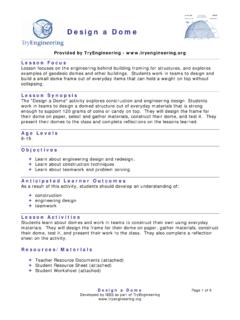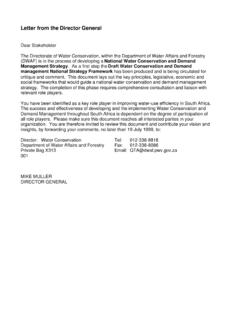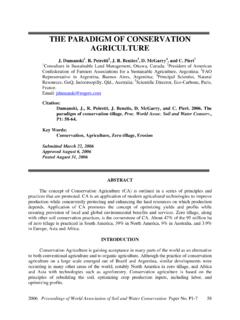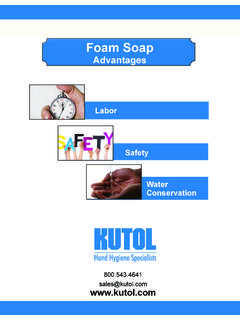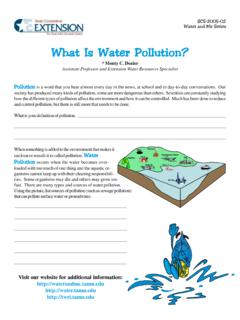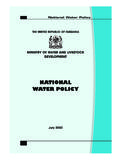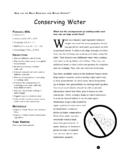Transcription of Water Tower Challenge - TryEngineering
1 Water Tower Challenge Page 1 of 11 Developed by IEEE as part of TryEngineering Water Tower Challenge Provided by TryEngineering - Lesson Focus Lesson focuses on Water storage and how engineering helps communities preserve and supply Water to populations. Students work in teams to design and build a Water Tower out of everyday materials that can "supply" and "shut off" Water as needed. The system will need to deliver Water in a controlled manner to a paper cup that is about 36 inches or 90 cm away in a controlled manner. They design their Tower , build and test their system, evaluate their results, and share observations with their class. Lesson Synopsis The " Water Tower Challenge " lesson explores how engineers work to solve the challenges of a society, such as delivering safe drinking Water .
2 Students work in teams to devise a system using every day materials that can deliver Water in a controlled manner to a paper cup that is about 36 inches or 90 cm away in a controlled manner. They sketch their plans, build their system, test it, reflect on the Challenge , and present to their class. Age Levels 8-18. Objectives Learn about engineering design and redesign. Learn about Water delivery systems. Learn how engineering can help solve society's challenges . Learn about teamwork and problem solving. Anticipated Learner Outcomes As a result of this activity, students should develop an understanding of: engineering design Water systems teamwork Lesson Activities Students explore how engineers have solved societal problems such as Water delivery and storage. Students work in teams to develop a Water Tower out of everyday materials than can deliver Water in a controlled manner to a paper cup.
3 They evaluate their results, and the results of other teams, and share their reflections with the class. Water Tower Challenge Page 2 of 11 Developed by IEEE as part of TryEngineering Resources/Materials Teacher Resource Documents (attached) Student Resource Sheet (attached) Student Worksheet (attached) Alignment to Curriculum Frameworks See curriculum alignment sheet at end of lesson. I nternet Connections TryEngineering ( ) Water towers ( ) National Science Education Standards ( ) ITEA Standards for Technological Literacy ( ) Recommended Reading Water towers (ISBN: 978-0262022774) Design for Water : Rainwater Harvesting, Stormwater Catchment, and Alternate Water Reuse (ISBN: 978-0865715806) Optional Writing Activity Write an essay or a paragraph about environmental challenges to a Water Tower design.
4 Consider how the weather, topography, the population of an area, or other factors might impact the design of a new Water Tower . Optional Extension Activity Have students test their designs to see if they are scalable by doubling and tripling the distance from the Water source to the cup. Water Tower Challenge Page 3 of 11 Developed by IEEE as part of TryEngineering Water Tower Challenge For Teachers: Teacher Resources Lesson Goal The " Water Tower Challenge " lesson explores how engineers work to solve the challenges of a society, such as delivering safe drinking Water . Students work in teams to devise a system using every day materials that can deliver Water in a controlled manner to a paper cup that is about 36 inches or 90 cm away in a controlled manner.
5 They sketch their plans, build their system, test it, reflect on the Challenge , and present to their class. Lesson Objectives Learn about engineering design and redesign. Learn about Water delivery systems. Learn how engineering can help solve society's challenges . Learn about teamwork and problem solving. Materials Student Resource Sheets Student Worksheets Classroom Materials ( Water source, bucket or sink area) Student Team Materials: paper cups, straws, paper towels, rubber bands, paper clips, tape, balloons, soda bottle, glue, string, foil, plastic wrap, pens, pencils, paper, hose or tubes, siphon materials, paper towels, other items available in the classroom. Procedure 1. Show students the student reference sheets. Th ese may be read in class or provided as reading material for the prior night's homework. 2. To introduce the lesson, consider asking the students how Water is supplied to their homes.
6 Ask them to think about the buildings and systems required to deliver safe drinking Water to their home. 3. Teams of 3-4 students will consider their Challenge , and conduct research into how Water towers operate. 4. Teams then consider available materials and develop a detailed drawing showing their Water Tower including a list of materials they will need to build it. 5. Students build their Water Tower , and test it, and also observe the systems developed and tested by other student teams. 6. Teams reflect on the Challenge , and present their experiences to the class. Time Needed Two to three 45 minute sessions. Water Tower Challenge Page 4 of 11 Developed by IEEE as part of TryEngineering Water Tower Challenge Student Resource: Water towers and Hydrostatic Pressure What is a Water Tower ?
7 A Water Tower is a large elevated drinking Water storage container that is engineered to safely hold a Water supply at a height sufficient to pressurize a Water distribution system. It needs to be big enough to supply residents of a community, or a building, with Water , and also maintain the quality of the Water that is stored and delivered. There are many designs for Water towers all over the world. Some have become landmarks and are decorated whimsically. In certain areas, such as large cities, smaller Water towers are constructed for individual buildings. Early Water towers were often designed as part of a building. What does the one in your town look like? What is Hydrostatic Pressure? Hydrostatic pressure is the pressure exerted by a fluid at equilibrium due to the force of gravity. It is the pressure of the Water that forces Water to flow through pipes into homes.
8 If the pressure is not strong enough, Water will not be delivered, or will be delivered too weakly to suffice for some applications such as fire hoses or showers. The higher the tank is and the larger the tank is, the more pressure and force that the Water will have. Sometimes pumps are also used to push Water through the Water delivery system, especially at peak usage times. When engineers design a Water Tower , they know that every vertical foot adds .43 pounds per square inch to the Water pressure. (Note: 1 psi equals 6, Pascals.) Most towns regulate Water pressure at between fifty and one-hundred pounds per square inch, so a simple equation tells them how high to build the Tower . Building a Water Tower A wide range of materials are used to construct Water towers -- including steel and reinforced concrete, with an interior coating to protect the Water from any effects from the building material.
9 The reservoir in the Tower may be in many shapes, and they usually have a minimum height of approximately 6 metres (20 ft) and are a minimum of 4 m (13 ft) in diameter. Most Water towers have a height of about 40 m (130 ft).The illustration to the right shows: 1. A pumping station to push Water up int o the Water , 2. A reservoir to hold the Water , and 3. Examples of how the Water might be used in a home, office, or apartment building. Water Tower Challenge Page 5 of 11 Developed by IEEE as part of TryEngineering Water Tower Challenge Student Resource: All About Patents What Is a Patent? A patent for an invention is the grant of a property right to the inventor, issued by a country's Patent and Trademark Office. The procedure for granting patents, the requirements placed on the patentee, and the extent of the exclusive rights vary widely between countries according to national laws and international agreements.
10 In the United States, the term of a new patent is 20 years from the date on which the application for the patent was filed or, in special cases, from the date an earlier related application was filed, subject to the payment of maintenance fees. Utility patents protect useful processes, machines, articles of manufacture, and compositions of matter. Some examples: fiber optics, computer hardware, medications. Design patents guard the unauthorized use of new, original, and ornamental designs for articles of manufacture. The look of a specific athletic shoe or a bicycle helmet are protected by design patents. Plant patents are the way we protect invented or discovered asexually reproduced plant varieties. Hybrid tea roses, Silver Queen corn, and Better Boy tomatoes are all types of plant patents. Famous Patents Safety Pin: The patent for the "safety pin" was issued on April 10, 1849 to Walter Hunt, of New York.


